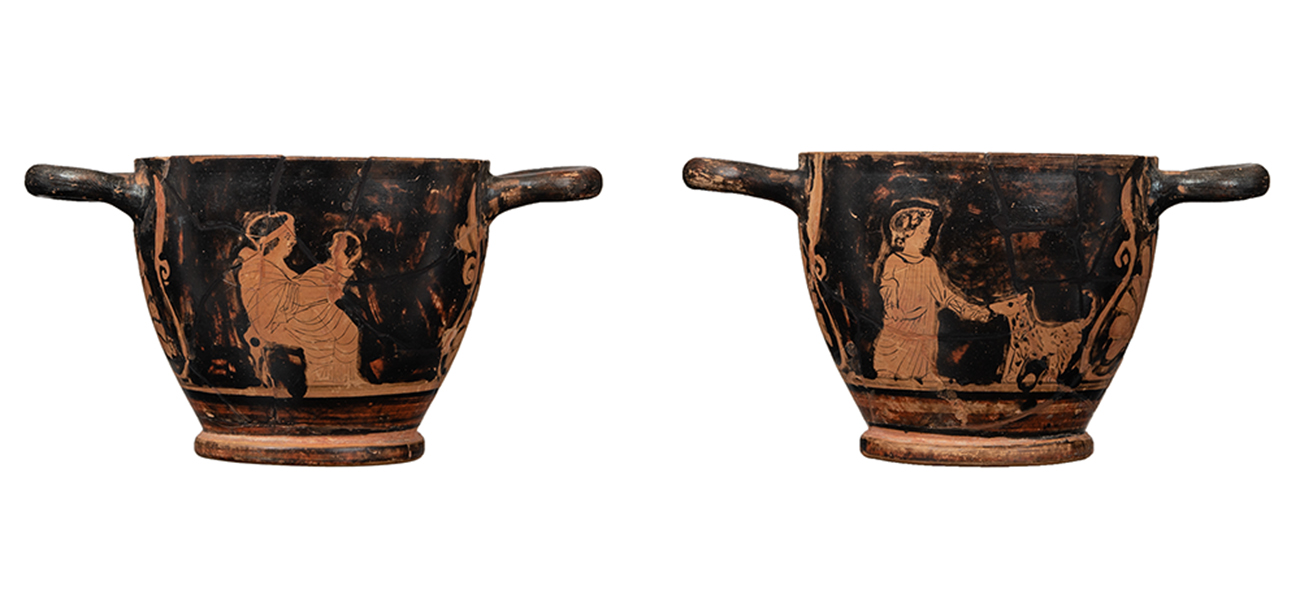Exhibit of the month
A sacrificial scene with unusual protagonists
Boeotian red-figure skyphos
Attributed to the Painter of the Dancing Pan
National Archaeological Museum
Vase Collection, inv. no. Α 12591
Provenance: Unknown (Papademas Collection)
Dimensions: Ht. 8.7–8.9 cm.
Date: Ca. 420 BC
Display location: Room 56, Showcase 141.
Standing in the showcase among the impressive red-figure vases of the Boeotian workshop, the small skyphos A 12591 passes almost unnoticed. However, a closer look reveals how remarkable it is, bearing scenes that shed light on private rituals in the context of popular beliefs.
On the one side a seated woman wearing a chiton and himation, a fillet in her hair, holds a swaddled baby in her arms. On the other side a wreathed little boy tries to lure a dog towards him. This scene could have been one of many depicting children with their beloved pets, had the boy not been dressed as a priest (he wears the characteristic long ungirt short-sleeved chiton of priests over a festive chiton with long embroidered sleeves) and had he not held in his right hand a big knife. The child seems ready to sacrifice the dog. As unrealistic as this thought may seem today, dog sacrifices were not unknown in ancient Greek and Roman religious-magical practices, especially in purification rites. Indeed, in the minds of the ancients, the dog was an unclean animal and was therefore ideal for sacrifices of this type, in which it functioned as a katharma absorbing the pollution (miasma) and thus securing the desired purification. A well-known example is provided by the dog sacrifices to Hekate, while during the rite of periskylakismos puppies were rubbed on the bodies of those seeking cleansing. Dogs were also used for the purification of the army in Macedonia during the festival of the Xandika, in public purification ceremonies in Boeotia, whereas in Sparta ephebes sacrificed puppies to Ares/Enyalios before the contests taking place in Platanistas (an island in the Eurotas river).
The reason behind the dog sacrifice on our skyphos, however, is to be found on the other side of the vase, depicting the woman holding the baby. Is she the mother of the infant herself or a kourotrophos goddess? In any case, it is well known that childbirth and early childhood were controlled by severe chthonic goddesses, whom expectant mothers or women who had just given birth sought to propitiate: at Argos dogs were sacrificed to Eilioneia, while in Attica, at cape Kolias, a similar sacrifice was offered to the Genetyllides. Hekate was also the recipient of such sacrifices as goddess of childbirth and nurturer of children (kourotrophos), as also possibly Eileithyia.
It is therefore reasonable to conclude that the impending sacrifice of the dog on the Boeotian skyphos is an allusion to a private purification ritual associated with childbirth. It is not coincidental that already from the Middle Geometric period until the 2nd/1st century BC, dog remains are frequently associated with female graves, foetus and infant disposal in wells, and possibly also with women who died in childbirth.
The good state of preservation of the Boeotian skyphos may imply a funerary findspot; moreover, judging from its small size and iconography one can reasonably assume that it accompanied a child to the grave.
Dr Christina Avronidaki
Bibliography
C. Avronidaki, “Boeotian Red Figure Imagery on two New Vases by the Painter of the Dancing Pan”, Antike Kunst 51 (2008) 8–14, 15, 16, 19, 20, fig. 1, pl. 5,1–3 and 6,4–5.
C. Avronidaki, Corpus Vasorum Antiquorum Athens 9, 134-136, pl. 53, 68,6, fig. 48 (in print).


